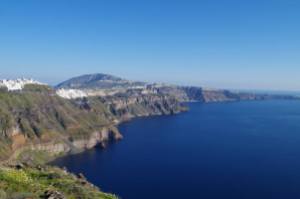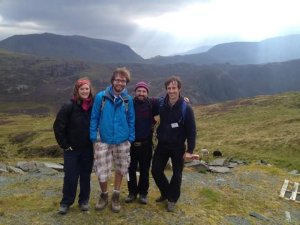Lancaster to London via the world, a volcanological tour by John Browning

Four years ago I left London to start a Master’s degree in Volcanology and Geological Hazards at the University of Lancaster. I am now preparing to defend my PhD thesis on ‘The thermo-mechanical effects of magma chambers and caldera faults’ at Royal Holloway, University of London and then in early 2016 begin a post-doctoral research assistant position in experimental rock deformation at University College London.
I had decided during the second year of my undergraduate degree in Environmental Hazards and Disaster Management at Kingston University (London) that I wanted to embark on a PhD related to volcanoes or natural hazards. The trouble was that PhD opportunities were lacking, which was partly due to my qualifications and experience. Whilst I obtained a top grade at Kingston most PhD projects looked for someone with more research experience that ideally held an MSc or had worked on volcanoes previously. So, after 10 years of living in London I departed for the beautiful city of Lancaster.
The MSc course at Lancaster offered everything that I needed to develop my research skills. Taught lessons were interesting, challenging and novel, and the practical sessions equally so. By far my favourite part of the course was the opportunity to conduct independent research, alongside the volcanologists Hugh Tuffen and Mike James. I was lucky enough to use a state-of-the-art piece of experimental apparatus for my final research project. Our results have been presented at international conferences and are now being written into a scientific paper. We experimentally determined the speed at which bubbles grow in a certain type of explosive magma called rhyolite, which involved creating films of magma frothing.
As well as lab work I was also lucky enough to carry out extensive fieldwork during my period at Lancaster. The most notable was a field campaign to Mt Etna in Italy, where our team witnessed the growth of a cinder cone through intermittent explosions and lava flows in one of the volcano’s craters. This work, published in the journal ‘Remote Sensing’, sheds light on ideas regarding growth rates of volcanoes, which we determined using a long-range laser scanner.
Since leaving Lancaster and embarking on a PhD at Royal Holloway, University of London I have presented my work and attended conferences and workshops in Austria, Germany, Greece, Ireland, Iceland, Italy, New Zealand, USA and Spain. I have conducted extensive field campaigns in Iceland where we investigated the inner workings of a 5 million year old volcano to discover how magma rises through volcanoes prior to eruptions and how enormous depressions called volcanic calderas are formed. In late 2014 the subglacial volcano Bárðarbunga in Iceland produced a huge eruption which may have driven collapse of the central part of the volcano, deepening the caldera beneath the ice. Numerical modelling studies that I was conducting at Royal Holloway were used to estimate how much the ground around the volcano would move if a collapse really had occurred and led to a paper in the Journal of Volcanology and Geothermal Research that has helped constraint the collapse mechanisms.
In Greece I conducted field work at the famous and mysterious Santorini volcano, whose eruptions are believed to have led to the demise of the Minoan civilisation and possible home to the lost city of Atlantis. Here I took measurements of magma-filled fractures by taking a boat around the caldera wall. Later we used these measurements to build a model which estimated how much magma is contained below Santorini volcano. Our study presents a new technique, recently published in the journal ‘Nature Scientific Reports’, which will hopefully lead to an increased chance of forecasting volcanic eruptions worldwide. The paper was featured in articles from Phys.org and others.

The spectacular volcanic island of Santorini
As well as field work and computer based modelling I also conducted a series of experiments at the Rock and Ice Physics laboratory of University College London. These tests utilised high temperature (>900°C) apparatus to investigate the effects of cooling on volcanic rocks and their tendency to crack and fracture. I will continue this and other experimental research at UCL during a post-doctoral post. My future research will aim to understand the three-dimensional nature of fracture and faulting in various types of rock using a brand new experimental apparatus called a true-triaxial deformation rig. I envisage that the results will be useful for understanding how magma rises through volcanoes and the mechanics of earthquakes.
As well as exciting research, I have also been really lucky to partake in a lot of outreach, widening participation and community activities surrounding my volcanological studies. I have been working with a charity called ‘The Brilliant Club’ to deliver university style in school tutorials on subjects such as volcano-tectonics, astrophysics and engineering throughout my PhD.

Joining fellow Lancaster Volcanology alumni Amy Chadderton and Jamie Farquharson, now studying for volcano-related PhDs in London and Strasbourg, on a fieldtrip in Cumbria with Hugh Tuffen (right), who directs the Lancaster Volcanology MSc
My time at Lancaster has allowed me to pursue a career in volcanological and Earth science research. I believe this would not have been possible without undertaking the MSc in Volcanology and Geothermal Research. During and since leaving Lancaster I have visited volcanoes all over the world, my top five so far are….. 5) Ruapehu, New Zealand, 4) Teidi, Tenerife, 3) Askja, Iceland, 2) Vulcano, Italy, and 1) Santorini, Greece… and you’ll have to get in contact for an explanation as to why I choose these!
Follow John on twitter: https://twitter.com/bahramiarmy

